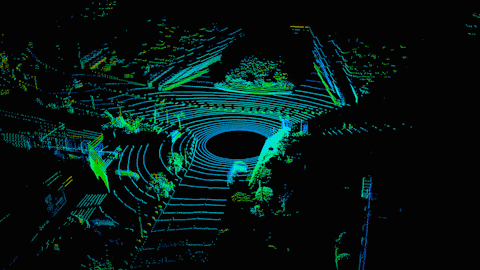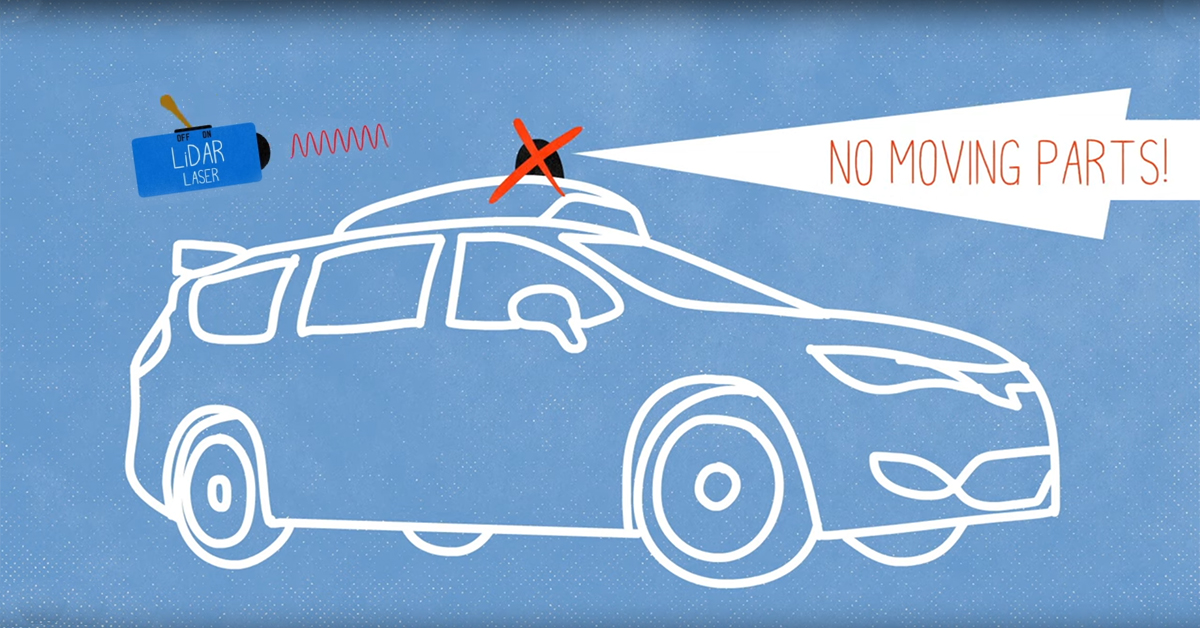Technology
How Self-Driving Cars “See” the World
How Self-Driving Cars “See” the World
Modern cars bear little resemblance to their early ancestors, but the basic action of steering a vehicle has always remained the same. Whether you’re behind the wheel of a Tesla or a vintage Model T, turning the wheel dictates the direction of movement. This simple premise, which places humans at the center of control, may be ripe for disruption as tech giants and car companies race toward a future that would render human-controlled vehicles obsolete.
How does this next generation of self-driving cars “see” the road? Today’s video from TED-Ed explains one of the mind-bending innovations making autonomous vehicles a reality.
Eye of the Laser
Safely getting a vehicle and its passengers from point A to B is no simple matter.
First, weather and time of day can create a wide variety of challenging situations, affecting things like visibility, braking distances, or speed. Next, other vehicles, bikes, and pedestrians are constantly moving through the transportation network, sometimes in unpredictable ways. To further complicate matters, the road network is rarely in optimum form. Road lines fade and construction can throw ambiguous detours into the mix.
Sensing and analyzing the world at a granular level is crucial in making self-driving cars a viable transportation option. To solve this problem, new generations of autonomous vehicles are using photonic integrated circuits, as well as light detection and ranging (LiDAR) to generate an extremely nuanced picture of the road ahead.

How self-driving cars see the world. (Source: Hesai)
LiDAR – which is related to RADAR – uses short laser pulses to sense the depth and shape of objects. Essentially, scattered bursts reflect off objects around the vehicle, painting a detailed 3D picture of its surroundings. LiDAR’s depth resolution is so accurate that it could eventually see details at the millimeter scale.
A Dissenting Opinion
While most companies in the autonomous vehicle space have fully embraced LiDAR, Tesla has a divergent point of view. The company employs a combination of GPS, cameras, and other sensors to help its cars visualize the world.
LiDAR is a fool’s errand. Anyone relying on LiDAR is doomed.
– Elon Musk
Society and Self-Driving Cars
While companies like Uber and Waymo determine the functional mechanics of self-driving cars, the rest of society is left to ponder how this new technology will affect employment, privacy, and personal autonomy.
In the U.S., more than 70% of goods are moved by truck, and over 80% of commuters take a private vehicle to work on any given day. Even partial automation of the nation’s transportation network will have wide-sweeping impacts on the economy.
As AI-powered cars and trucks hit the streets at scale, how cars see the road will be a detail most of us will overlook. The bigger question will be whether we are ready for a society where we’re no longer in the driver’s seat.
Technology
Charting the Next Generation of Internet
In this graphic, Visual Capitalist has partnered with MSCI to explore the potential of satellite internet as the next generation of internet innovation.

Could Tomorrow’s Internet be Streamed from Space?
In 2023, 2.6 billion people could not access the internet. Today, companies worldwide are looking to innovative technology to ensure more people are online at the speed of today’s technology.
Could satellite internet provide the solution?
In collaboration with MSCI, we embarked on a journey to explore whether tomorrow’s internet could be streamed from space.
Satellite Internet’s Potential Customer Base
Millions of people live in rural communities or mobile homes, and many spend much of their lives at sea or have no fixed abode. So, they cannot access the internet simply because the technology is unavailable.
Satellite internet gives these communities access to the internet without requiring a fixed location. Consequently, the volume of people who could get online using satellite internet is significant:
| Area | Potential Subscribers |
|---|---|
| Households Without Internet Access | 600,000,000 |
| RVs | 11,000,000 |
| Recreational Boats | 8,500,000 |
| Ships | 100,000 |
| Commercial Aircraft | 25,000 |
Advances in Satellite Technology
Satellite internet is not a new concept. However, it has only recently been that roadblocks around cost and long turnaround times have been overcome.
NASA’s space shuttle, until it was retired in 2011, was the only reusable means of transporting crew and cargo into orbit. It cost over $1.5 billion and took an average of 252 days to launch and refurbish.
In stark contrast, SpaceX’s Falcon 9 can now launch objects into orbit and maintain them at a fraction of the time and cost, less than 1% of the space shuttle’s cost.
| Average Rocket Turnaround Time | Average Launch/Refurbishment Cost | |
|---|---|---|
| Falcon 9* | 21 days | < $1,000,000 |
| Space Shuttle | 252 days | $1,500,000,000 (approximately) |
Satellites are now deployed 300 miles in low Earth orbit (LEO) rather than 22,000 miles above Earth in Geostationary Orbit (GEO), previously the typical satellite deployment altitude.
What this means for the consumer is that satellite internet streamed from LEO has a latency of 40 ms, which is an optimal internet connection. Especially when compared to the 700 ms stream latency experienced with satellite internet streamed from GEO.
What Would it Take to Build a Satellite Internet?
SpaceX, the private company that operates Starlink, currently has 4,500 satellites. However, the company believes it will require 10 times this number to provide comprehensive satellite internet coverage.
Charting the number of active satellites reveals that, despite the increasing number of active satellites, many more must be launched to create a comprehensive satellite internet.
| Year | Number of Active Satellites |
|---|---|
| 2022 | 6,905 |
| 2021 | 4,800 |
| 2020 | 3,256 |
| 2019 | 2,272 |
| 2018 | 2,027 |
| 2017 | 1,778 |
| 2016 | 1,462 |
| 2015 | 1,364 |
| 2014 | 1,262 |
| 2013 | 1,187 |
Next-Generation Internet Innovation
Innovation is at the heart of the internet’s next generation, and the MSCI Next Generation Innovation Index exposes investors to companies that can take advantage of potentially disruptive technologies like satellite internet.
You can gain exposure to companies advancing access to the internet with four indexes:
- MSCI ACWI IMI Next Generation Internet Innovation Index
- MSCI World IMI Next Generation Internet Innovation 30 Index
- MSCI China All Shares IMI Next Generation Internet Innovation Index
- MSCI China A Onshore IMI Next Generation Internet Innovation Index
MSCI thematic indexes are objective, rules-based, and regularly updated to focus on specific emerging trends that could evolve.

Click here to explore the MSCI thematic indexes

-

 Technology2 weeks ago
Technology2 weeks agoCountries With the Highest Rates of Crypto Ownership
While the U.S. is a major market for cryptocurrencies, two countries surpass it in terms of their rates of crypto ownership.
-

 Technology2 weeks ago
Technology2 weeks agoMapped: The Number of AI Startups By Country
Over the past decade, thousands of AI startups have been funded worldwide. See which countries are leading the charge in this map graphic.
-

 Technology3 weeks ago
Technology3 weeks agoAll of the Grants Given by the U.S. CHIPS Act
Intel, TSMC, and more have received billions in subsidies from the U.S. CHIPS Act in 2024.
-

 Technology4 weeks ago
Technology4 weeks agoVisualizing AI Patents by Country
See which countries have been granted the most AI patents each year, from 2012 to 2022.
-

 Technology4 weeks ago
Technology4 weeks agoHow Tech Logos Have Evolved Over Time
From complete overhauls to more subtle tweaks, these tech logos have had quite a journey. Featuring: Google, Apple, and more.
-

 AI1 month ago
AI1 month agoRanked: Semiconductor Companies by Industry Revenue Share
Nvidia is coming for Intel’s crown. Samsung is losing ground. AI is transforming the space. We break down revenue for semiconductor companies.
-

 United States7 days ago
United States7 days agoMapped: Countries Where Recreational Cannabis is Legal
-

 Healthcare2 weeks ago
Healthcare2 weeks agoLife Expectancy by Region (1950-2050F)
-

 Markets2 weeks ago
Markets2 weeks agoThe Growth of a $1,000 Equity Investment, by Stock Market
-

 Markets2 weeks ago
Markets2 weeks agoMapped: Europe’s GDP Per Capita, by Country
-

 Money2 weeks ago
Money2 weeks agoCharted: What Frustrates Americans About the Tax System
-

 Technology2 weeks ago
Technology2 weeks agoCountries With the Highest Rates of Crypto Ownership
-

 Mining2 weeks ago
Mining2 weeks agoWhere the World’s Aluminum is Smelted, by Country
-

 Personal Finance2 weeks ago
Personal Finance2 weeks agoVisualizing the Tax Burden of Every U.S. State














